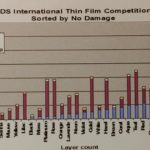Neodymium-doped ytt rium aluminium garnet (Nd-YAG) crystal is a common lasing medium used in solid state lasers. It has been used and researched since 1964. The laser is designed by replacing a few yttrium irons in the crystal structure of the garnet with neodymium irons. The ions of YAG and yttrium are similarly sized, which is why the replacement is effective. The neodymium ion acts as a lasing medium.
The Nd:YAG has excellent properties for Q-switched and high-power lasers. It produces a continuous laser at room temperature. The rods are typically small and so the laser can be fitted in portable systems.
The 4-level laser gain medium with a relatively small gain bandwidth offers great results at moderate excitation levels and pump intensities. The Nd-YAG laser is efficient and needs lower threshold pump power as a result. It is possible to lamp-pump or diode-pump the laser. Lamp pumping is allowed by the 4-level gain medium and the broadband pump absorption at mainly 800 nm.
The laser emits infrared light at 1064 nm. But other wavelengths are also possible including 940 nm, 1120 nm, 1320 nm, and 1440 nm.
The common monocrystalline Nd:YAG crystal is grown using the Czochralski method. But manufacturers are also developing larger and high quality ceramics. Scattering and absorption losses in both types of lasers are usually negligible no matter how long the crystal.
In many cases, YAG lasers are monolithic, such as nonplanar ring oscillators and microchip lasers.
The Nd:YAG laser has the chemical formula Y3Al5O12. It has a cubic crystal structure that measures 8 to 8.5 on the Mohs hardness scale. It has a mass density of 4.56 g/cm cube. Young’s modulus is 280 GPa. Tensile strength is 200 MPa. The crystal melts at 1970°C.
Thermal conductivity is 10 to 14 W/ (m K). It’s thermal expansion coefficient is 7 – 8 . 10-6 K. The thermal shock resistance parameter is 790 W/M. Birefringence is none at room temperature, only thermally induced. The refractive index of the crystal at 1064 nm is 1.82.
Nd:YAG lasers are used in manufacturing:
- To etch and engrave plastics and metals.
- To cut and weld steel, semiconductors and other metal alloys.
- To make subsurface markings on glass or acrylic.
The portability of the Nd: YAG laser system means that it is popular in Q-switched applications in the aesthetic and cosmetic industry. Applications typically include treatments for:
- Hair removal
- Pigmentation
- Melasma
- Acne
- Dark skin
- Tattoo removal
- Spider veins
- Skin whitening
This laser is used widely in ophthalmology, in YAG laser eye surgery, in procedures like:
- YAG laser iridotomy to relieve blocks in the pupil in glaucoma
- The correction of posterior capsular opacification, a common complication of cataract surgery. In YAG laser capsulotomy, the eye is dilated and the laser is used to clear proteins behind the implanted lens and restore vision.
Applications in other medical fields such as oncology include:
- Treatment of benign thyroid nodules
- Treatment of skin cancer
- Treatment of primary and secondary malignant liver lesions.
Nd YAG laser is also used in dentistry, for treatment of soft tissue and hard tissue in procedures like:
- Gingivectomy
- Gingivoplasty
- Biopsy
- Operculectomy
- Incising and draining procedures
- Treatment of aphthous ulcers
- Frenectomy
- Enamel etching
- Decay vaporisation
- Exposed root desensitisation
Nd: YAG laser and Argon lasers are most commonly used in surgery that is less-invasive than traditional methods. The effect that a laser has on a tissue sample depends on the properties of the tissue, water content, conductivity, density, ability to scatter, absorb and reflect the emitted energy.
Nd: YAG lasers produce a largely scattering effect on tissue because there are no tissue chromophores that absorb light at the 1064 nm wavelength. Tissue penetration of the laser is therefore low. Reflected light leads to a beam that is not cohesive and narrow. Tissue heats up slowly, making the YAG laser ideal for tumor necrosis, hemostasis and several endoscopic procedures such as laparoscopy.
In the aesthetic industry, these lasers are preferred because they gently penetrate skin for the purpose of vaporising scar tissue, stimulating new collagen production, sealing overactive sebaceous glands, and offering benefits of skin tone and texture.
Nd:YAG lasers can be used to visualise flow in fluid dynamics, for instance in techniques like laser-induced fluorescence and particle image velocimetry.
They are used for research applications such as Raman spectroscopy, remote sensing and mass spectrometry.
They are frequently used to build optical tweezers for applications in biophysics research. Biological samples are mostly made of water. They have a low coefficient of absorption at the wavelength that the Nd:YAG laser emits.
Nd:YAG lasers are commonly used to analyse elements in the periodic table, replacing more time-taking and expensive processes such as ICP and XRF.
Nd:YAG lasers are also used to pump tunable visible light lasers in various applications.
These lasers are commonly used in laser rangefinders and laser designators. The risk of laser eye injury is high in these applications, as a high-powered laser emitting at 1064 nm is not eye-safe. The invisible laser is often not noticed and no pain is felt. UN body CCWC prohibits the use of blinding laser weapons.
The Nd:YAG is also being researched in Japan in the form of chips, to replace a spark plug in vehicles. Pulsed lasers at 800 picosecond-long pulses are being tested to ignite fuel. There is hope that such an ignition system could yield better fuel economy and performance, with lower emissions.
Argon lasers were used popularly in surgeries until the more efficient and successful Nd:YAG laser began to be used.
Popular neodymium-doped alternatives to Nd:YAG are Nd:YLF, Nd:YVO4 and Yb:YAG. Higher power and higher efficiency give some of these lasers advantages over Nd:YAG in some applications.

